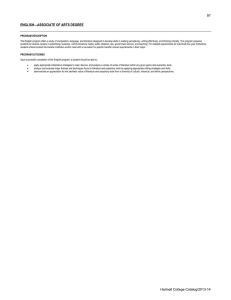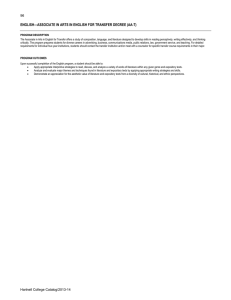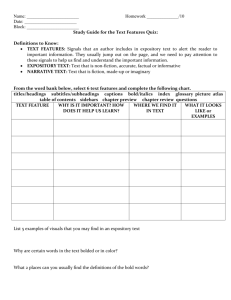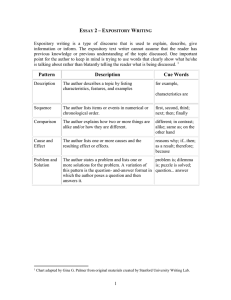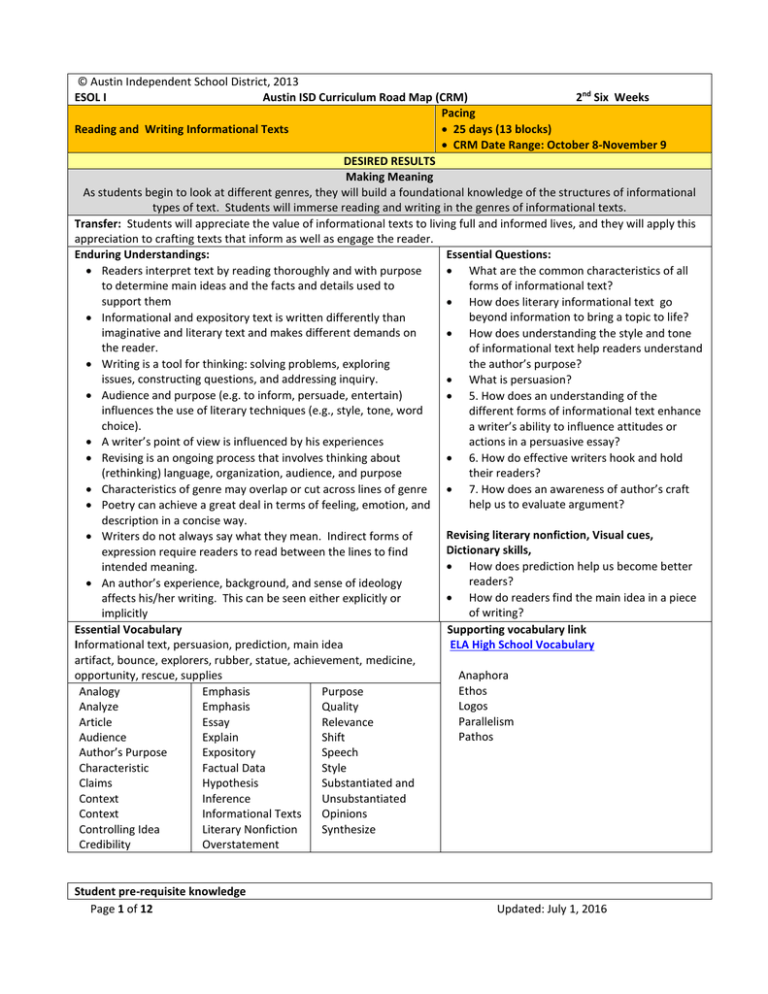
© Austin Independent School District, 2013
ESOL I
Austin ISD Curriculum Road Map (CRM)
2nd Six Weeks
Pacing
Reading and Writing Informational Texts
25 days (13 blocks)
CRM Date Range: October 8-November 9
DESIRED RESULTS
Making Meaning
As students begin to look at different genres, they will build a foundational knowledge of the structures of informational
types of text. Students will immerse reading and writing in the genres of informational texts.
Transfer: Students will appreciate the value of informational texts to living full and informed lives, and they will apply this
appreciation to crafting texts that inform as well as engage the reader.
Enduring Understandings:
Essential Questions:
Readers interpret text by reading thoroughly and with purpose
What are the common characteristics of all
to determine main ideas and the facts and details used to
forms of informational text?
support them
How does literary informational text go
beyond information to bring a topic to life?
Informational and expository text is written differently than
imaginative and literary text and makes different demands on
How does understanding the style and tone
the reader.
of informational text help readers understand
Writing is a tool for thinking: solving problems, exploring
the author’s purpose?
issues, constructing questions, and addressing inquiry.
What is persuasion?
Audience and purpose (e.g. to inform, persuade, entertain)
5. How does an understanding of the
influences the use of literary techniques (e.g., style, tone, word
different forms of informational text enhance
choice).
a writer’s ability to influence attitudes or
actions in a persuasive essay?
A writer’s point of view is influenced by his experiences
Revising is an ongoing process that involves thinking about
6. How do effective writers hook and hold
(rethinking) language, organization, audience, and purpose
their readers?
Characteristics of genre may overlap or cut across lines of genre
7. How does an awareness of author’s craft
help us to evaluate argument?
Poetry can achieve a great deal in terms of feeling, emotion, and
description in a concise way.
Revising literary nonfiction, Visual cues,
Writers do not always say what they mean. Indirect forms of
Dictionary skills,
expression require readers to read between the lines to find
How does prediction help us become better
intended meaning.
readers?
An author’s experience, background, and sense of ideology
How do readers find the main idea in a piece
affects his/her writing. This can be seen either explicitly or
of writing?
implicitly
Essential Vocabulary
Supporting vocabulary link
Informational text, persuasion, prediction, main idea
ELA High School Vocabulary
artifact, bounce, explorers, rubber, statue, achievement, medicine,
opportunity, rescue, supplies
Anaphora
Ethos
Analogy
Emphasis
Purpose
Logos
Analyze
Emphasis
Quality
Parallelism
Article
Essay
Relevance
Pathos
Audience
Explain
Shift
Author’s Purpose
Expository
Speech
Characteristic
Factual Data
Style
Claims
Hypothesis
Substantiated and
Context
Inference
Unsubstantiated
Context
Informational Texts
Opinions
Controlling Idea
Literary Nonfiction
Synthesize
Credibility
Overstatement
Student pre-requisite knowledge
Page 1 of 12
Updated: July 1, 2016
Development of academic language and grammatical structures are a major factor in academic success of ELLs. In addition,
ELLs are acquiring English language at the same time they are learning content in English. ELLs are expected to meet the
same standards in a second language that many monolingual English speakers find difficult in their first language.
Resources:
Longman Keystone Texas website www.texasesol.com and
http://portal.mypearson.com/mypearson-login.jsp
Pearson Longman Keystone 1A Teacher Edition
Longman Keystone Teacher’s Resource Book with
Glencoe ELLevate Teacher Resource: Strategies for ELLs book
Newcomer pages 94-123
and website www.ellevate.glencoe.com
Longman Keystone Placement & Exit Test
A+RISE online ELPS resource in Project Share
http://www.epsilen.com or www.arises2s.com/texas
Longman Keystone Student Text
Longman Keystone Student Workbook
The ELAR textbook adopted by Austin ISD has these ELL
Longman Keystone Reader’s Companion
resources:
Longman Keystone Student e-book CD ROM
Prentice-Hall Literature Reader’s Notebook English Learner’s
Longman Keystone Assessment book,
version (9, 10, 11, 12)
Longman Keystone Transparencies
Prentice-Hall
Literature Reader’s Notebook Spanish version
Longman Keystone Program Audio CD
(9,
10,
11,
12)
Longman Keystone Teacher e-book & Examview CD
Prentice-Hall Teacher’s Edition Language Central (9, 10,no 11
Longman Keystone Video Program DVD
or 12)
Longman Keystone Phonics Kit includes flash cards, 5
www.PHLitOnline.com
student workbooks, 2 readers A & B, 1 Teacher’s
Edition
Prentice Hall Literature Texas edition, (Selections by Grade,
Six Traits of Writing pamphlet
Genre, and Lexile, English II Writing Resources,
Penguin Readers-18 readers
ELA
curriculum documents and resources
Online Success tracker and essay scorer
www.pearsonsuccessnet.com
ELPS: Mandated by Texas Administrative Code (19 TAC §74.4), click on the link for English Language Proficiency Standards
(ELPS) to support English Language Learners.
ARC # 1 : Introducing the Genre
Arc Pacing: 1 week, 2.5 Blocks
Targeted Vocabulary: Essay, Article, Controlling Idea, Claims, Speech, Context, Emphasis, Author’s Purpose, Audience,
artifact, bounce, explorers, rubber, statue
Resources: English 1 TEKS, Texas college and Readiness Standards (CCRS), Technology Applications TEKS,
Austin ISD ELL Academic Plan 2011-2012, Resources pp. 160-164. (hyperlink takes you to aisdweb intranet)
TEKS Knowledge & Skills
Acquisition Important knowledge and skills
STAAR: RC = Reporting Category; DC =
Students Will Know
Students Will Be Able To
Dual Coded Skills; Readiness Standard;
Supporting Standard Concepts are
addressed in another unit.
E1.8 Reading/Comprehension of Informational Text/Culture and History. Students will analyze, make inferences and draw
conclusions about the author's purpose in cultural, historical, and contemporary contexts and provide evidence from the
text to support their understanding. The student is expected to:
(8A) explain the controlling idea and
Authors write for specific
Analyze and evaluate the central
specific purpose of an expository text
message of an expository text and
purposes to specific audiences.
and distinguish the most important from
make unique connections to
the less important details that support
relevant text.
The central idea of a work is
the author's purpose RC3
created by details and some of
Evaluate the author’s purpose and
the details are more important
make unique personal and literary
than others.
connection.
Analyze the structure of the text
and the relevance of both
important and less important
Page 2 of 12
Updated: July 1, 2016
details.
Choose relevant, specific and
meaningful textual evidence to
support his or her analysis.
Show comprehension through
inferential skills.
Show comprehension through
analytic skills.
E1.9 Reading/Comprehension of Informational Text/Expository Text. Students analyze, make inferences and draw
conclusions about expository text and provide evidence from text to support their understanding. The student is expected
to:
(9A) summarize text and distinguish
An author can write an expository
Compare a summary and a
between a summary that captures the
text from either a neutral or
critique.
main ideas and elements of a text and a
persuasive position.
Show comprehension through
critique that takes a position and
basic reading skills.
Mature readers can distinguish
expresses an opinion RC3
between opinions that are
supported with fact and those that
are not.
(9C ) make subtle inferences and draw
complex conclusions about the ideas in
text and their organizational patterns
RC3
Mature readers use their
knowledge of rhetorical devices
to critically interpret an author’s
message.
Use own knowledge of rhetorical
devices to critically interpret an
author's message.
Expand repertoire of language
learning strategies to acquire
language. ELPS 1H
Show comprehension through
inferential skills.
E1.10 Reading/Comprehension of Informational Text/Persuasive Text. Students analyze, make inferences and draw
conclusions about persuasive text and provide evidence from text to support their analysis.. The student is expected to:
(10B) analyze famous speeches for the
demonstrate English
Break apart and analyze rhetorical
rhetorical structures and devices used to
comprehension and expand reading
structures and craft and evaluate
convince the reader of the authors'
skills by employing analytical skills
their efficacy in promoting an
propositions RC3
such as evaluating written
author's argument.
information and performing critical
Contribute to making meaning of
analyses commensurate with
persuasive texts in informational
content-area and grade-level needs
text centers.
E1.11 Reading/Comprehension of Informational Text/Procedural Texts. Students understand how to glean and use
information in procedural texts and documents. The student is expected to:
(11A) analyze the clarity of the
objective(s) of procedural text (e.g.,
consider reading instructions for
software, warranties, consumer
publications) RC3
Page 3 of 12
demonstrate English
comprehension and expand reading
skills by employing analytical skills
such as evaluating written
information and performing critical
analyses commensurate with
content-area and grade-level needs
Use text information and graphics
in procedural texts to glean and
use information
Analyze and utilize the data
presented in multiple graphical
sources, resulting in the ability to
understand/complete a task
Updated: July 1, 2016
ARC #2 : Author’s Craft: Expository
Arc Pacing: 1 week
Targeted Vocabulary: artifact, bounce, explorers, rubber, statue
Resources: English 1 TEKS, Texas college and Readiness Standards (CCRS), Technology Applications TEKS,
Austin ISD ELL Academic Plan 2011-2012, Resources pp. 160-164. (hyperlink takes you to aisdweb intranet)
TEKS Knowledge & Skills
Acquisition Important knowledge and skills
STAAR: RC = Reporting Category; DC =
Students Will Know
Students Will Be Able To
Dual Coded Skills; Readiness Standard;
Supporting Standard Concepts are
addressed in another unit.
E1.8 Reading/Comprehension of Informational Text/Culture and History. Students will analyze, make inferences and draw
conclusions about the author's purpose in cultural, historical, and contemporary contexts and provide evidence from the
text to support their understanding. The student is expected to:
(8A) explain the controlling idea and
Authors write for specific
Analyze and evaluate the central
specific purpose of an expository text
purposes to specific audiences.
message of an expository text and
and distinguish the most important from
make unique connections to
The central idea of a work is
the less important details that support
relevant text.
created by details and some of
the author's purpose RC3
the details are more important
Evaluate the author’s purpose and
than others.
make unique personal and literary
connections.
Analyze the structure of the text
and the relevance of both
important and less important
details.
Choose relevant, specific and
meaningful textual evidence to
support his or her analysis.
Show comprehension through
inferential skills.
Show comprehension through
analytic skills.
D1.9 Reading/Comprehension of Informational Text/Expository Text. Students analyze, make inferences and draw
conclusions about expository text and provide evidence from text to support their understanding. The student is expected
to:
(9A)summarize text and distinguish
An author can write an
Compare a summary and a
between a summary that captures the
expository text from either a
critique.
main ideas and elements of a text and a
neutral or persuasive position.
Provide own summary and
critique that takes a position and
Mature readers can distinguish
critique.
expresses an opinion RC3
between opinions that are
Provide substantiated opinions
(9B) differentiate between opinions that
supported with fact and those
and make complex inferences and
are substantiated and unsubstantiated
that are not.
conclusions.
in the text RC3
Mature readers use their
Use own knowledge of rhetorical
(9C) make subtle inferences and draw
knowledge of rhetorical devices
devices to critically interpret an
complex conclusions about the ideas in
to critically interpret an author’s
author's message.
text and their organizational patterns
message.
RC3
Contribute to making meaning of
Students will know how to
expository texts in informational
(9D) synthesize and make logical
determine the meaning of
connections between ideas and details
Page 4 of 12
Updated: July 1, 2016
in several texts selected to reflect a
range of viewpoints on the same topic
and support those findings with textual
evidence RC1
unknown words using common
affixes and resources such as
dictionaries.
Knowing how to compare
attitudes and beliefs between
and among texts from the same
period gives a perspective on
how literature and society are
connected.
text centers.
Show comprehension through
basic reading skills.
Show comprehension through
analytic skills.
Develop and expand repertoire of
learning strategies such as
reasoning inductively or
deductively, looking for patterns in
language, and analyzing sayings
and expressions
E1.15 Writing/Expository and Procedural Texts. Students write expository and procedural or work-related texts to
communicate ideas and information to specific audiences for specific purposes. The student is expected to:
(15A) write an analytical essay of
Analytical and expository writing
Write an expository essay that
sufficient length that includes RC4
explain and describe an issue.
explains an issue.
(15Ai) effective introductory and
concluding paragraphs and a variety of
sentence structures RC4/RC5
(15Aii) rhetorical devices, and
transitions between paragraphs
RC4/RC5
(15Aiii) a controlling idea or thesis
RC4/RC5
(15Aiv) an organizing structure
appropriate to purpose, audience, and
context RC4/RC5
(15Av) relevant information and valid
inferences RC4/RC5
Introductions and conclusions
draw the reader and leave the
text feeling complete.
Write introductions and conclusions
that serve the message of the
writing.
Writer's strategies like rhetorical
devices and transitions help the
readers appreciate the writer's
message.
Use rhetorical devices and
transitions which bolster writer's
message.
Theses (main ideas) focus the
writing.
The more focused the writing, the
more likely the reader will be
informed and engaged by the
text.
Organization not only clarifies
meaning, it also serves to
emphasize meaning.
The quality of a writer's evidence
will affect the efficacy of his or
her message.
Craft a focused and meaningful
thesis.
Decide upon and implement an
organizing structure that serves a
writer's message.
Select evidence that best supports
their message.
Write using variety of sentence
structures and words.narrate,
describe, and explain with
increasing specificity and detail to
fulfill content-area writing needs as
more English is acquired.
ARC #3 : Author’s Craft: Comparing Poetry and Expository
Arc Pacing: 1.5 weeks
Targeted Vocabulary:
Resources: English 1 TEKS, Texas college and Readiness Standards (CCRS), Technology Applications TEKS,
Austin ISD ELL Academic Plan 2011-2012, Resources pp. 160-164. (hyperlink takes you to aisdweb intranet)
TEKS Knowledge & Skills
Acquisition Important knowledge and skills
STAAR: RC = Reporting Category; DC =
Students Will Know
Students Will Be Able To
Dual Coded Skills; Readiness Standard;
Supporting Standard Concepts are
addressed in another unit.
E1.2 Reading/Comprehension of Literary Text/Theme and Genre. Students analyze, make inferences and draw
conclusions about theme and genre in different cultural, historical, and contemporary contexts and provide evidence from
the text to support their understanding. The student is expected to:
(2B) analyze the influence of mythic,
Students will know the
Identify attributes of mythic,
Page 5 of 12
Updated: July 1, 2016
classical and traditional literature on
20th and 21st century literature RC2
attributes of mythic, classical
and traditional literature.
classical, and traditional literature
in 20th and 21st century literature.
Describe the effect of the
attributes on contemporary
literature.
Show comprehension through
analytic skills. ELPS 4K
E1.3 Reading/Comprehension of Informational Text/Expository Text. Students analyze, make inferences and draw
conclusions about expository text and provide evidence from text to support their understanding. The student is expected
to:
(3A) analyze the effects of diction and
Poets use particular writing
Read, understand, interpret and
imagery (e.g., controlling images,
strategies for their genre: line
analyze simple and complex poems.
figurative language, understatement,
structure, enjambment, etc.
Compare poetry to other genres.
overstatement, irony, paradox) in poetry
Poets use writing strategies other
RC2
Contribute to making meaning of
writers use in their genres:
poetry in a literature circle.
diction, controlling imagery,
figurative language,
Read linguistically accommodated
understatement, overstatement,
content-area materials. ELPS 4E
irony, and paradox).
Show comprehension through
inferential skills. ELPS 4J.
E1.9 Reading/Comprehension of Informational Text/Expository Text. Students analyze, make inferences and draw
conclusions about expository text and provide evidence from text to support their understanding. The student is expected
to:
(9A)summarize text and distinguish
An author can write an
Compare a summary and a
between a summary that captures the
expository text from either a
critique.
main ideas and elements of a text and a
neutral or persuasive position.
Provide own summary and
critique that takes a position and
critique.
Mature readers can distinguish
expresses an opinion RC3
between opinions that are
Provide substantiated opinions
(9B) differentiate between opinions that
supported with fact and those
and make complex inferences and
are substantiated and unsubstantiated
that are not.
conclusions.
in the text RC3
Mature readers use their
Use own knowledge of rhetorical
(9C) make subtle inferences and draw
knowledge of rhetorical devices
devices to critically interpret an
complex conclusions about the ideas in
to critically interpret an author’s
author's message.
text and their organizational patterns
message.
RC3
Contribute to making meaning of
Students will know how to
expository texts in informational
(9D) synthesize and make logical
determine the meaning of
text centers.
connections between ideas and details
unknown words using common
in several texts selected to reflect a
affixes and resources such as
Show comprehension through
range of viewpoints on the same topic
dictionaries.
basic reading skills. ELPS 4I
and support those findings with textual
Knowing how to compare
Show comprehension through
evidence RC1
attitudes and beliefs between
analytic skills. ELPS 4K
and among texts from the same
Develop and expand repertoire of
period gives a perspective on
learning strategies such as
how literature and society are
reasoning inductively or
connected.
deductively, looking for patterns in
language, and analyzing sayings
Page 6 of 12
Updated: July 1, 2016
and expressions. ELPS 1H
E1.15 Writing/Expository and Procedural Texts. Students write expository and procedural or work-related texts to
communicate ideas and information to specific audiences for specific purposes. The student is expected to:
(15A) write an analytical essay of
Analytical and expository writing
Write an expository essay that
sufficient length that includes RC4
explain and describe an issue.
explains an issue.
(15Ai) effective introductory and
concluding paragraphs and a variety of
sentence structures RC4/RC5
(15Aii) rhetorical devices, and
transitions between paragraphs
RC4/RC5
(15Aiii) a controlling idea or thesis
RC4/RC5
(15Aiv) an organizing structure
appropriate to purpose, audience, and
context RC4/RC5
(15Av) relevant information and valid
inferences RC4/RC5
Introductions and conclusions
draw the reader and leave the
text feeling complete.
Write introductions and conclusions
that serve the message of the
writing.
Writer's strategies like rhetorical
devices and transitions help the
readers appreciate the writer's
message.
Use rhetorical devices and
transitions which bolster writer's
message.
Theses (main ideas) focus the
writing.
The more focused the writing, the
more likely the reader will be
informed and engaged by the
text.
Organization not only clarifies
meaning, it also serves to
emphasize meaning.
The quality of a writer's evidence
will affect the efficacy of his or
her message.
Craft a focused and meaningful
thesis.
Decide upon and implement an
organizing structure that serves a
writer's message.
Select evidence that best supports
their message.
Write using variety of sentence
structures and wordsELPS
5Fnarrate, describe, and explain
with increasing specificity and detail
to fulfill content-area writing needs
as more English is acquired ELPS 5G
ARC #4 : Author’s Craft: Persuasive
Arc Pacing: 1.5 weeks, 3.5 Blocks
Targeted Vocabulary: Overstatement, Substantiated and Unsubstantiated, Opinions
Resources: English 1 TEKS, Texas college and Readiness Standards (CCRS), Technology Applications TEKS,
Austin ISD ELL Academic Plan 2011-2012, Resources pp. 160-164. (hyperlink takes you to aisdweb intranet)
TEKS Knowledge & Skills
Acquisition Important knowledge and skills
STAAR: RC = Reporting Category; DC =
Students Will Know
Students Will Be Able To
Dual Coded Skills; Readiness Standard;
Supporting Standard Concepts are
addressed in another unit.
E1.8 Reading/Comprehension of Informational Text/Culture and History. Students will analyze, make inferences and draw
conclusions about the author's purpose in cultural, historical, and contemporary contexts and provide evidence from the
text to support their understanding. The student is expected to:
(8A) explain the controlling idea and
specific purpose of an expository text
and distinguish the most important from
the less important details that support
the author's purpose RC3
Authors write for specific
purposes to specific audiences.
The central idea of a work is
created by details and some of
the details are more important
than others.
Analyze and evaluate the central
message of an expository text and
make unique connections to
relevant text.
Evaluate the author’s purpose and
make unique personal and literary
connections.
Analyze the structure of the text
and the relevance of both
important and less important
details.
Page 7 of 12
Updated: July 1, 2016
Choose relevant, specific and
meaningful textual evidence to
support his or her analysis.
Show comprehension through
inferential skills. ELPS 4J
Show comprehension through
analytic skills. ELPS 4K
E1.11 Reading/Comprehension of Informational Text/Procedural Texts. Students understand how to glean and use
information in procedural texts and documents. The student is expected to:
(11A) analyze the clarity of the
Procedural texts provide
Use text information and graphics in
objective(s) of procedural text (e.g.,
directions or instructions.
procedural texts to glean and use
consider reading instructions for
information.
Charts, graphs and images
software, warranties, consumer
provided in text and electronically
Show comprehension through
publications) RC3
contribute to a reader’s
analytic skills. ELPS 4K
(11B) analyze factual, quantitative, or
understanding of the information.
Analyze and utilize the data
technical data presented in multiple
presented in multiple graphical
graphical sources RC3
sources, resulting in the ability to
understand/complete a task.
Contribute to making meaning of
expository texts in procedural text
centers.
E1.12 Reading/Media Literacy. Students use comprehension skills to analyze how words, images, graphics, and sounds
work together in various forms to impact meaning. Students will continue to apply earlier standards with greater depth in
increasingly more complex texts. The student is expected to:
(12A) compare and contrast how events
Media take advantage of the
Identify the wide range of medium
are presented and information is
dynamic range offered by
in media and how its creators use it
communicated by visual images (e.g.,
visuals, graphics, illustrations,
to their advantage.
graphic art, illustrations, news
and photographs to
Use techniques to learn new
photographs) versus non-visual texts
communicate about events.
vocabulary. ELPS 1C
RC2/RC3
A viewer must be aware of the
Analyze tools used in print text vs.
(12B) analyze how messages in media are
intended audience, the author’s
tools used in visual text that are
conveyed through visual and sound
message, and which tools the
used to create a similar message.
techniques (e.g., editing, reaction shots,
author uses to create the
sequencing, background music)
message.
Derive meaning from a variety of
media. ELPS 2F
(12C) compare and contrast coverage of
Different news outlets and
the same event in various media (e.g.,
genres report events differently. Compare and contrast coverage of
newspapers, television, documentaries,
same events in various media.
Shifts usually indicate a clue to
blogs, Internet)
meaning.
Contribute to making meaning of
text in informational text centers.
Looks for shifts as clues to interpret
a text.
(12D) evaluate changes in formality and
tone within the same medium for specific
audiences and purposes RC2/RC3
Show comprehension through
analytic skills. ELPS 4K
E1.15 Writing/Expository and Procedural Texts. Students write expository and procedural or work-related texts to
communicate ideas and information to specific audiences for specific purposes. The student is expected to:
Page 8 of 12
Updated: July 1, 2016
(15A) write an analytical essay of
sufficient length that includes RC4
(15Ai) effective introductory and
concluding paragraphs and a variety of
sentence structures RC4/RC5
(15Aii) rhetorical devices, and
transitions between paragraphs
RC4/RC5
(15Aiii) a controlling idea or thesis
RC4/RC5
(15Aiv) an organizing structure
appropriate to purpose, audience, and
context RC4/RC5
(15Av) relevant information and valid
inferences RC4/RC5
Page 9 of 12
Analytical and expository writing
explain and describe an issue.
Write an expository essay that
explains an issue.
Introductions and conclusions
draw the reader and leave the
text feeling complete.
Write introductions and conclusions
that serve the message of the
writing.
Writer's strategies like rhetorical
devices and transitions help the
readers appreciate the writer's
message.
Use rhetorical devices and
transitions which bolster writer's
message.
Theses (main ideas) focus the
writing.
The more focused the writing, the
more likely the reader will be
informed and engaged by the
text.
Organization not only clarifies
meaning, it also serves to
emphasize meaning.
The quality of a writer's evidence
will affect the efficacy of his or
her message.
Craft a focused and meaningful
thesis.
Decide upon and implement an
organizing structure that serves a
writer's message.
Select evidence that best supports
their message.
Write using variety of sentence
structures and wordsELPS
5Fnarrate, describe, and explain
with increasing specificity and detail
to fulfill content-area writing needs
as more English is acquired ELPS 5G
Updated: July 1, 2016
ASSESSMENT EVIDENCE
TEA mandate requires the use of linguistic accommodations for ELLs as determined by the LPAC.
Data is available from LPAS (Language Proficiency Assessment System.)
Refer to http://www.tea.state.tx.us/student.assessment/accommodations
Student Work Products/Assessment Evidence
Performance Tasks
Other Evidence (i.e. unit tests, open ended exams, quiz, essay,
Choose from the tasks below based on ELL
proficiency level and your pacing.
Informational text center participation
Visual representation of different informational
text organization strategies
Processed expository essay
Graphic organizers comparing subgenres
student work samples, observations, etc.)
Short Cycle Assessment
MOY I Reading:
1B, 1E, 2, 2B, 2C
Expository with Graphic: 8A, 9, 9A, 9B, 9C, 9D, 12, 12A, 12C
Poem: F19B, 3, 3A
Short Story: F19B, 5, 5A, 5B, 5C, 7A
Consumer evaluation of media
Ongoing list of writing strategies and examples in
writer’s notebook
Students practice asking what, where, when,
who, how and why to ask informative questions.
Quickwrite- Students work together to create a
chart to share information about their favorite
ball games and ball players
Students use a timeline to plan a biographical
narrative about a hero and then use the timeline
to write
Able to use informational questions- Grammar
focus
Page 10 of 12
MOY I Writing:
Composition: 13 B-D, 15Ai-v (Expository)
Revising: 13C, 16 A, 16C, 16D, 16E
Editing: 13D, 17A, 17Ai, 17Aii, 17C, 18A, 18Bi, 19A
Window: November 5-9
Eligible ELLs may use linguistic accommodations when taking SCAs
or other assessments. Refer to
http://www.tea.state.tx.us/student.assessment/accommodations/
Additional Suggestions for Assessment
Group responses comparing expository text to poems
Analysis processed essay or quick write
Updated: July 1, 2016
LESSON PLANNING TOOLS
Teacher Notes
1. Additional text selections at different lexile levels are available in the Resources section, p 2 of this CRM.
(See link: Prentice Hall Literature Texas edition, (Selections by Grade, Genre, and Lexile, English II Writing
Resources)
2. Several lessons are included for each arc. Choose lessons based on proficiency of your ELLs and pacing
considerations.
In the course of lesson planning, it is the expectation that teachers will include whole child considerations when
planning such as differentiation, special education, English language learning, dual language, gifted and talented, social
emotional learning, physical activity, and wellness.
ESOL Exemplar Lesson 1 - Arc 1: Introducing the Genre-Informational Text: Longman Keystone 1A Unit 2, Texas Skill
Builders Literary Nonfiction, “My Texas Desert” pp. T118-123
Suggested Pacing: 2 days/1 block
TEKS: 6
ESOL Exemplar Lesson 2 - Arc 1: Introducing the Genre-Informational Text: Longman Keystone 1A Unit 3 “Play Ball” pp.
94-104
Suggested Pacing: 4 days/2 blocks
TEKS: 4A, 6, 8A, 9A
ESOL Exemplar Lesson 3 - Arc 1: Introducing the Genre-Informational Text: Longman Keystone 1A Unit 2, Informational
Text, Selection 2: “Earthquakes,”pp. T76-80
Suggested Pacing: 2 days/1 block
TEKS: 6, 8A, 9C, 11B
ELA Exemplar Lesson 4 - Arc 1: Informational Text “Stereotypes That Kill”
Suggested Pacing: 2 days/1 block
TEKS: 9, 9A, 9D
ESOL Exemplar Lesson 1 - Arc 2: Author’s Craft: Expository. Longman Keystone 1A Unit 3, Informational Text, Roberto
Clemente” pp. T104-114
Suggested Pacing: 4 days/2 blocks
TEKS: 4A, 8A, 17A, 17C, 18B
ELA Exemplar Lesson 2 - Arc 2: Expository: “This I Believe”
Suggested Pacing: 4 days/4 blocks
TEKS: F19B , 17C, 8A, E1.9, 9C, 9D, 15, 15Aiii
ESOL Exemplar Lesson 1 - Arc 3: Comparing poetry and expository. Longman Keystone 1A Unit 6, “Animal Senses,” pp
196-199, and “Wings,” pp 201
Suggested Pacing: 2 days/1 block
TEKS: E1.3A, E1.8A, E1.9A
ELA Exemplar Lesson 2 - Arc 3: Author’s Craft: Comparing Expository and Poetry: “An Adventure in American Culture and
Values”
Suggested Pacing: 1 day/1 block
TEKS: F19B, 1B, 3, 7, 7A
Page 11 of 12
Updated: July 1, 2016
LESSON PLANNING TOOLS
Teacher Notes
1. Additional text selections at different lexile levels are available in the Resources section, p 2 of this CRM.
(See link: Prentice Hall Literature Texas edition, (Selections by Grade, Genre, and Lexile, English II Writing
Resources)
2. Several lessons are included for each arc. Choose lessons based on proficiency of your ELLs and pacing
considerations.
In the course of lesson planning, it is the expectation that teachers will include whole child considerations when
planning such as differentiation, special education, English language learning, dual language, gifted and talented, social
emotional learning, physical activity, and wellness.
ESOL Exemplar Lesson 1- Arc 4: Author’s Craft: Persuasive. “from The American Crisis, Number 1,” Thomas Paine,
Prentice-Hall Literature Reader’s Notebook English Learner’s version, pp. 55-57.
Suggested Pacing: 3 days/1.5 blocks
TEKS: 8, 8A, 11, 12
ELA Exemplar Lesson 2 - Arc 4: Author’s Craft:Persuasive Text: “I Have a Dream”
Suggested Pacing: 3 days/1.5 blocks
TEKS: F19, F19A , 8, 8A, 9C, 9D, 16, 16A, 16D
Instructional Resource
www.starfall.com
www.eflnet.com
www.pumarosa.com
www.daveseslcafe.com
www.colorincolorado.com
Page 12 of 12
Austin ISD ELL Academic Plan 2013-2014, Resources pp. 160-164. (hyperlink
takes you to aisdweb intranet)
Navigating the ELPS in the English Language Arts and Reading Classroom:
Using the Standards to improve instruction for ELLs, (J. Seiditz).
English I STAAR Writing Resources
Updated: July 1, 2016

